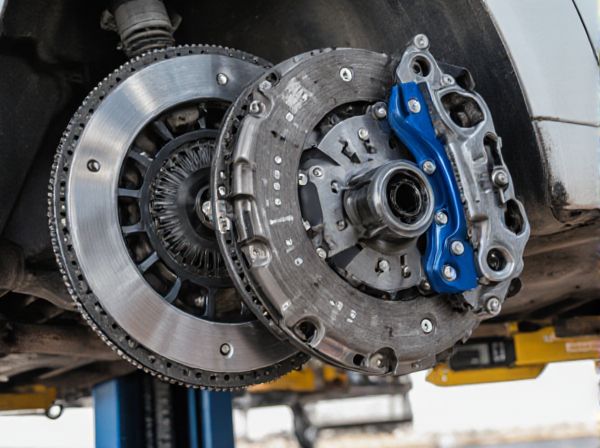
Photo illustration: Twin-Disc Clutch vs Triple-Disc Clutch
A twin-disc clutch offers increased torque capacity and smoother engagement compared to a single-disc, making it ideal for high-performance street vehicles. Triple-disc clutches provide even greater torque handling and durability, suitable for extreme racing or heavy-duty applications where maximum power transfer and heat dissipation are critical. Choose your clutch type based on your vehicle's power output and intended use to ensure optimal performance and reliability.
Table of Comparison
| Feature | Twin-Disc Clutch | Triple-Disc Clutch |
|---|---|---|
| Number of Friction Discs | 2 | 3 |
| Torque Capacity | Moderate - Suitable for stock and mildly tuned engines | High - Designed for high-performance and racing applications |
| Heat Dissipation | Good | Better - More surface area for heat management |
| Pedal Effort | Lower - Easier to operate | Higher - Requires more force |
| Clutch Size | Compact | Larger - Requires more space |
| Durability | Good for moderate use | Enhanced for heavy-duty and track use |
| Cost | Lower | Higher |
| Typical Use Case | Daily driven cars, street performance | Competitive motorsports, high torque vehicles |
Overview of Twin-Disc and Triple-Disc Clutch Systems
Twin-disc clutch systems feature two friction discs, offering enhanced torque capacity and improved heat dissipation compared to single-disc setups, making them ideal for high-performance vehicles and heavy-duty applications. Triple-disc clutch systems incorporate three friction discs, providing even greater torque handling and smoother power transfer, suitable for extreme performance demands and racing conditions. Both systems balance durability and responsiveness, with triple-disc clutches delivering superior performance at the cost of increased complexity and weight.
Key Differences Between Twin-Disc and Triple-Disc Clutches
Twin-disc clutches feature two friction discs, providing moderate torque capacity and smoother engagement suited for everyday driving and light performance applications. Triple-disc clutches incorporate an additional friction disc, significantly increasing torque handling and durability, making them ideal for high-performance or heavy-duty vehicles. The key differences lie in torque capacity, heat dissipation, and clutch pedal effort, with triple-disc clutches offering enhanced performance but requiring more complex installation and maintenance.
Performance Capabilities: Twin-Disc vs Triple-Disc
Twin-disc clutches offer improved torque capacity and heat dissipation compared to single-disc clutches but may fall short in handling extreme power levels seen in high-performance or racing applications. Triple-disc clutches provide superior torque transmission and enhanced durability under intense conditions, making them ideal for heavy-duty and high-horsepower engines. Performance capabilities of triple-disc clutches exceed twin-disc clutches by offering increased clutch surface area, resulting in better grip and reduced slippage during aggressive driving.
Torque Handling and Power Delivery
Twin-disc clutches typically offer moderate torque handling, making them suitable for standard performance vehicles, while triple-disc clutches provide significantly higher torque capacity ideal for high-performance and heavy-duty applications. Power delivery in twin-disc clutches tends to be smoother and less aggressive due to fewer friction surfaces, whereas triple-disc clutches deliver more direct and robust power transfer, enhancing acceleration and overall drivability under extreme conditions. Enhanced thermal dissipation in triple-disc setups also contributes to improved durability and consistent performance during sustained high torque loads.
Clutch Engagement and Pedal Feel Comparison
Twin-disc clutches offer smoother engagement and lighter pedal feel due to fewer friction surfaces, enhancing driver comfort and control during moderate power applications. Triple-disc clutches provide increased torque capacity and improved heat dissipation, but generally result in a stiffer pedal and slightly less gradual engagement, suitable for high-performance or heavy-duty vehicles. The choice depends on balancing desired tactile feedback and the clutch's ability to handle power and heat under demanding conditions.
Suitability for Street vs Track Applications
Twin-disc clutches offer smooth engagement and are ideal for street applications where drivability and comfort are prioritized. Triple-disc clutches provide increased torque capacity and heat dissipation, making them suitable for track use and high-performance vehicles demanding aggressive power handling. Choosing between them depends on balancing everyday usability with the demands of competitive or spirited driving.
Longevity and Maintenance Considerations
Twin-disc clutches typically offer longer longevity due to fewer friction surfaces, resulting in less wear and simpler maintenance requirements. Triple-disc clutches provide higher torque capacity but tend to wear faster because of the increased number of friction plates, leading to more frequent servicing and higher maintenance costs. Choosing between the two depends on balancing performance needs with durability and maintenance intervals in specific applications.
Cost Comparison: Twin-Disc vs Triple-Disc Clutches
Twin-disc clutches generally cost less than triple-disc clutches due to fewer friction surfaces and simpler construction, making them a budget-friendly option for moderate performance needs. Triple-disc clutches command a higher price because of increased complexity, greater heat dissipation, and enhanced torque capacity, justifying the investment for high-performance or heavy-duty applications. The cost difference typically ranges from 20% to 50%, reflecting material and manufacturing intricacies inherent in triple-disc designs.
Installation Challenges and Requirements
Twin-disc clutches require precise alignment during installation to avoid uneven wear and ensure optimal performance, with demands for moderate torque capacity and straightforward hydraulic or mechanical actuation systems. Triple-disc clutches, designed for higher torque loads and heavier vehicles, present increased installation complexity due to their additional friction disc, necessitating specialized tools, careful spacing adjustments, and stronger pressure plates to handle expanded clutch pack thickness. Both types require attention to clean components and proper torque specifications on fasteners to prevent premature failure and maintain smooth engagement.
Choosing the Right Clutch: Factors to Consider
Selecting the right clutch between twin-disc and triple-disc options depends primarily on factors such as torque capacity, heat dissipation, and vehicle application. Twin-disc clutches offer smoother engagement and are typically suited for moderate performance vehicles, while triple-disc clutches provide higher torque handling and better durability for high-performance or heavy-duty applications. Consider the vehicle's power output, driving style, and specific performance requirements to ensure the clutch matches the operational demands effectively.
 caratoz.com
caratoz.com